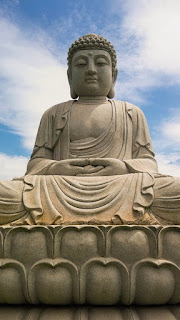Baudh dharm
- Gautama Buddha was born in 563 BC in a place called Lumbini of Kapilavastu.
- His father Shuddhodhan was the head of Shakya Gana.
- After the death of his mother Maya Devi, he was brought up by his step-mother Gautami.
- His childhood name was Siddhartha.
- Gautam Buddha was married at the age of 16 with Yashodhara and his son's name was Rahul.
- When Siddhartha went for a trip to Kapilvastu, he saw four scenes - 1. a bad person 2. a sick person 3. a body 4. a monk
- Disturbed by worldly problems, Siddhartha renounced the planet at the age of 29, which in Buddhism was called Mahabhinshikamana.
- After renouncing the planet, Siddhartha taught Sanskrit from Vaishali's Alarkalaam that Alarkala became Siddhartha's first guru.
- After Alarkalam, Siddhartha was educated at Rudrakramramput of Rajgir.
- In Uruvela, Siddhartha found five seekers named Koundinya, Vampa, Bhadiya, Mahanama, and Assagi.
- Siddhartha attained enlightenment under the Peepal tree on the banks of the Niranjana (Phalgu) river on the full moon night of Vaishakh at the age of 35 after a hard penance of 6 years without consuming food-water.
- After attaining enlightenment, Siddhartha became known as Buddha. And that place was called Bodh Gaya.
- Buddha gave his first sermon in Sarnath (Rishi), which was called the conversion of Buddhist texts.
- Buddha gave his teachings in Pali, the language of the common people.
- Buddha gave his sermons in Kaushal, Vaishali, Kaushambhi, and other states, but gave the most sermons in Kaushal's capital Shravasti.
- His followers were rulers - Bimbisara, Prasenjit, Udayin, Ashoka, etc. were kings.
- Buddha died in Kushinara (Deoria Uttar Pradesh) in 803 BC in 80 years of age, it has been called Mahaparinirvana in Buddhism.
- Mallow performed the funeral rites of Buddha with great respect.
- According to an observation, after the death, the remains of Buddha's body were divided into eight parts and eight stupas were constructed.
- The Chinese tradition of Buddha's date of birth and death has been determined on the basis of the Canton inscription.
- Buddhism is basically atheistic. It does not even have a vision of the soul.
- We get detailed knowledge about Buddhism from Tripitaka, the language of the three Pitko is Pali - Vinapitaka, Sutrapitaka, Abhidambhpitaka.
- There is a belief of rebirth in Buddhism.
- Buddha has called nirvana the condition of craving for cravings.
- The doctrine of "the world is full of sorrows" is derived from the Buddha's Upanishad.
- Buddha divided the followers into two parts.
- Bhikshuka - Those who took retirement to propagate Buddhism were called beggars.
- Worshiper - Those who practice Buddhism while living in the life of the planet, were called worshipers.
- The minimum age to join the Buddhist Union was 15 years.
- Entering into the Buddhist Sangha was called a sub-estate.
- There are triratnas of Buddhism - Buddha, Dhamma, Sangha.

House Time Place Chairman's reign
First 483 BC Rajagraha Mahakashyap AjatushtruII 383 BC Vaishali Sabakami Kalashok
III 255 AD Pataliputra Moggaliputta Ashoka
Fourth -First Century Kundalvan Vasumitra / Ashwaghos Kanishk
- After the fourth Buddhist music, the Buddhist religion was divided into two parts.
- The Bodhisattva is the ideal of the Mahayana sect of Buddhism, the Bodhisattva merges his nirvana by giving priority to the welfare of another.
- If you want to attain the ideal arhat status of Hinayana, a person achieves nirvana through his practice, he is called arhat.
- The religious procession first started with Buddhism.
- Buddhist religion is the most sacred festival Baishakh Purnima which is also known as Buddha Purnima.
- The importance of Baishakh Purnima is because on the day of Buddha Purnima, the birth of Mahatma Buddha, the attainment of knowledge and Mahaparinirvan were attained.
- In order to get rid of this worldly misery, Buddha talked about the asexual path - these are his means -
- 1. Right Vision 2. Right Resolution
- 3. Samyak Vani 4. Samyak Karmant
- 5. Samyukh Lively 6. Samyukta Exercise
- 7. Samyak Smriti 8. Samyak Samadhi
- Note- According to Mahatma Buddha, after observance of the paths, the desire of manusya is destroyed and he attains nirvana.
- The ultimate goal of Buddhism in Nirvana is the meaning of "extinguishing of the lamp", that is, to be freed from the cycle of life and death, Mahatma Buddha emphasized the following ten conditions to make Nirvana successful -
- 1.Good 2. Truth
- 3. Unstoppable (not stealing) 4. Aparigraha (not possessing property)
- 5. Not consuming honey 6. Not eating untimely food
- 7. Not sleeping in a pleasant bed 8. Not collecting money
- 9. Staying away from the arms 10. Staying away from the anthem
- It was mandatory for the planets to consider only the first five modesty and for monks ten modesty.
- Mahatma Buddha preached the Madhyam Marg (Madhyama per verse).
- Most Buddha statues were constructed under the Gandhar style
- But the first Buddha statue was probably built under the Mathura art.
- Padmasambhava (Guru Rinpanch) propagated Buddhism in Tibet, Bhutan and neighboring countries.
- It was related to the Brajyan branch of Buddhism.
- Its 123 feet high idol is in the Himalayan state Rewalsar lake.



Nice Blog, thank you. Visit Our Website.
ReplyDeletePunyatoya By Pratibha Ray
Order Odia Books
Odia Books Online